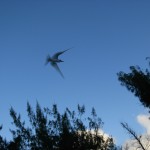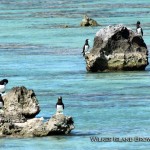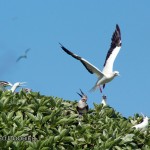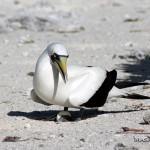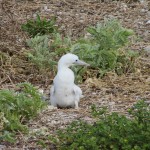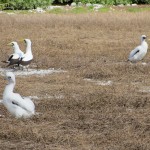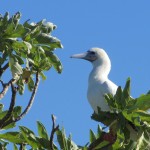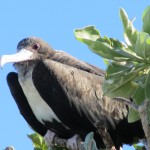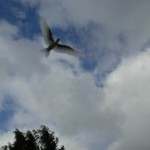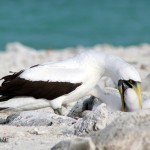Wake Island Birds
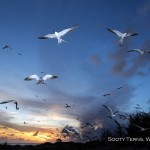 Wake’s human population may be small these days, but the neighborhoods are full to bursting with birds (see video link below!). The remote, isolated atoll has hosted a wide variety of migratory and resident seabirds for time out of mind. The ravages of the WWII Japanese occupation and postwar feral cat predation left indelible marks, but researchers are encouraged by signs of robust recovery across the atoll.
Wake’s human population may be small these days, but the neighborhoods are full to bursting with birds (see video link below!). The remote, isolated atoll has hosted a wide variety of migratory and resident seabirds for time out of mind. The ravages of the WWII Japanese occupation and postwar feral cat predation left indelible marks, but researchers are encouraged by signs of robust recovery across the atoll.
During my visit to Wake in the fall of 2011 I was captivated by the graceful white terns that would appear from the trees on Wake and Peale, hover overhead, and peer down at me with their big black eyes. Aptly, they are also known as fairy terns. (Not being a scientist or avid birder, I won’t be providing scientific names here.)
Wilkes is the designated bird refuge, marked with a broad mowed zone on the western end – the equivalent of a flashing neon “Open” sign for birds – to attract the big nesters and keep them out of the air traffic zone. On a November afternoon we saw modest numbers of boobies, sooty terns, and others, but evening brought a screeching cacophony to Wilkes that indicated: Sooty Tern Party On! They come by the thousands to roost; on one day, August 24, 1964, scientists estimated there were one million sooty terns on the atoll (see Rauzon below). Also called “Wide Awake” for obvious reasons, this tern’s Hawaiian name is ‘Ewa ‘ewa (screech it over and over!).
Please watch Kauai photographer Timothy DeLaVega’s beautiful video Wake in Time, filmed on Wake last year. The footage of sea and sky interspersed with WWII structures and ruins and the birds provide a wonderful window on Wake. Chopin’s Raindrop Prelude is the perfect accompaniment for the film, and you can’t miss the sooty tern interlude. Come back here for more after you enjoy Tim’s video.
In “The Status of the Birds of Wake Atoll” by Mark J. Rauzon, et al., a research bulletin issued by the Smithsonian Institution’s National Museum of Natural History in 2008, the annotation of confirmed bird species on Wake reflects their resurgence after multiple depredations and extreme weather events. The dramatic increase from 31 bird species in 1995 to 56 species in 2008, Rauzon argues, owes much to feral cat control and eradication between 1996 and 2004 and the beginning stages of the rat control program that was initiated in 2006.
Many species have returned to their prewar densities, according to Rauzon’s 2008 report, including “albratross, noddies, terns, shearwaters, tropicbirds, ducks and shorebirds,” though some have had less success with breeding. Sooty Terns, shearwaters, boobies and frigatebirds are primary users of the Wilkes Bird Refuge. One species, the Wake Rail, will never return: it was hunted to extinction during the starving time of the Japanese occupation in World War II (see Storrs L. Olson and Mark Rauzon, “The Extinct Wake Island Rail,” The Wilson Journal of Ornithology, December 2011).
While researching Building for War I encountered many references to Wake’s early twentieth century bird populations in the primary sources, and it’s interesting to compare these observations with modern studies. In 1939 Colonel Harry K. Pickett, USMC, noted that the big frigatebirds and boobies nested heavily on southeast Wake where they would likely endanger future aircraft operations. They would have to be “eliminated” for air operation safety. Indeed, the CPNAB contractors bulldozed the nesting colonies in 1941 to build the first landplane runways.
Writing home on February 7, 1941, Harry Olson described Wake’s birds including boobies, frigates, a “sort of benign buzzard,” some snipe, and “a species of rail bird. These last look somewhat like a quail but cannot fly.” Many in 1941 joked about the flightless little rail bird; little did they know they would be among the last humans to see a living one. About the bigger birds, Harry wrote:
The boobies and frigates are very tame, or should I say have not sense enough to be afraid. They set up a plaintive sort of clamor in a scolding sort of fashion when approached but won’t fly until you are about ten feet away. Then they usually get all tangled up in the limbs of the tree or bush they are roosting on and get mad at themselves, the bush, and you. They have no control of themselves and regurgitate about this time. On Peale Island there is also a species of moaning bird (their name) that live in the ground and make a sad sort of cry like a lost soul in torment.
Typhoons, war, cats, and rats have all taken their toll on Wake’s bird population, but with the eradication of predatory animals the atoll now qualifies as “one of the best seabird colonies in the Western Pacific,” according to Rauzon, and by now the best in Micronesia. It is possible that the endangered Guam Rail may be introduced to Wake as a surrogate or replacement species for the extinct Wake Rail. The burgeoning bird population and drastic reduction of predators will alter the natural balance in new ways, but don’t look for Wake to turn into a guano island any time soon (though the increased elevation wouldn’t hurt).
Thanks to Tim DeLaVega for sharing his video and photographs, and to Karlene Leeper for more great bird photos.
- White Tern
- photo credit Tim DeLaVega
- photo credit Tim DeLaVega
- photo credit Tim DeLaVega
- photo credit Tim DeLaVega
- photo credit Karlene Leeper
- photo credit Tim DeLaVega
- photo credit Karlene Leeper
- photo credit Karlene Leeper
- photo credit Karlene Leeper
- White Tern
- photo credit Tim DeLaVega

